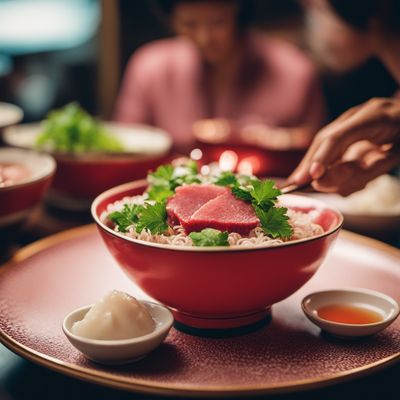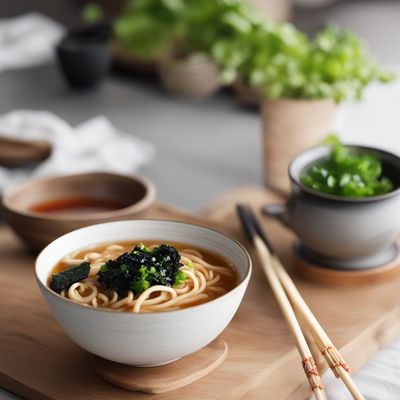
Recipe
Tanzanian-style Udon Noodles
Spicy Tanzanian Udon Delight
4.7 out of 5
Indulge in the flavors of Tanzania with this unique twist on the classic Japanese udon noodles. This Tanzanian-style udon recipe combines the rich and spicy flavors of Tanzanian cuisine with the comforting texture of udon noodles.
Metadata
Preparation time
15 minutes
Cooking time
15 minutes
Total time
30 minutes
Yields
4 servings
Preparation difficulty
Easy
Suitable for
Vegetarian, Vegan, Dairy-free, Nut-free, Gluten-free (if using gluten-free udon noodles)
Allergens
Soy
Not suitable for
Paleo, Keto, Low-carb, High-protein, Atkins
Ingredients
In this Tanzanian adaptation of udon noodles, we incorporate Tanzanian spices and flavors to give the dish a unique twist. The original Japanese udon is typically served in a soy-based broth, while the Tanzanian-style udon features a spicy sauce infused with ginger, garlic, cumin, and chili. Additionally, the use of vibrant Tanzanian vegetables like bell peppers, carrots, and cabbage adds a fresh and crunchy element to the dish. We alse have the original recipe for Udon (dish), so you can check it out.
-
250g (8.8 oz) udon noodles 250g (8.8 oz) udon noodles
-
2 tablespoons vegetable oil 2 tablespoons vegetable oil
-
1 onion, thinly sliced 1 onion, thinly sliced
-
2 cloves of garlic, minced 2 cloves of garlic, minced
-
1 tablespoon ginger, grated 1 tablespoon ginger, grated
-
1 teaspoon cumin powder 1 teaspoon cumin powder
-
1 teaspoon chili powder 1 teaspoon chili powder
-
1 bell pepper, thinly sliced 1 bell pepper, thinly sliced
-
1 carrot, julienned 1 carrot, julienned
-
1 cup shredded cabbage 1 cup shredded cabbage
-
2 tablespoons soy sauce 2 tablespoons soy sauce
-
1 tablespoon tomato paste 1 tablespoon tomato paste
-
Salt, to taste Salt, to taste
-
Fresh cilantro, for garnish Fresh cilantro, for garnish
Nutrition
- Calories (kcal / KJ): 320 kcal / 1340 KJ
- Fat (total, saturated): 8g, 1g
- Carbohydrates (total, sugars): 55g, 8g
- Protein: 9g
- Fiber: 6g
- Salt: 2g
Preparation
-
1.Cook the udon noodles according to the package instructions. Drain and set aside.
-
2.Heat the vegetable oil in a large pan or wok over medium heat.
-
3.Add the sliced onion and sauté until translucent.
-
4.Stir in the minced garlic, grated ginger, cumin powder, and chili powder. Cook for another minute until fragrant.
-
5.Add the sliced bell pepper, julienned carrot, and shredded cabbage to the pan. Stir-fry for 3-4 minutes until the vegetables are slightly tender.
-
6.In a small bowl, mix together the soy sauce and tomato paste. Pour the sauce over the vegetables and stir to coat evenly.
-
7.Add the cooked udon noodles to the pan and toss gently to combine with the sauce and vegetables.
-
8.Season with salt to taste.
-
9.Cook for an additional 2-3 minutes until the noodles are heated through.
-
10.Serve the Tanzanian-style udon noodles hot, garnished with fresh cilantro.
Treat your ingredients with care...
- Udon noodles — Cook the udon noodles according to the package instructions, but make sure not to overcook them as they should retain a slightly chewy texture.
- Ginger — Grate the ginger just before using to ensure maximum flavor.
- Cabbage — Shred the cabbage finely for a better texture in the dish.
- Soy sauce — Use low-sodium soy sauce if you prefer a less salty taste.
- Tomato paste — If you don't have tomato paste, you can substitute it with tomato sauce, but reduce the quantity to avoid making the dish too watery.
Tips & Tricks
- For an extra kick of heat, add a few dashes of hot sauce or chili flakes to the sauce.
- Customize the vegetable selection based on what is available and in season.
- Add protein such as tofu, tempeh, or cooked chicken for a heartier meal.
- Garnish with chopped peanuts or sesame seeds for added texture and flavor.
- Make a double batch of the sauce and store it in the refrigerator for future use.
Serving advice
Serve the Tanzanian-style udon noodles hot as a main course. Pair it with a side of fresh salad or steamed vegetables for a complete meal.
Presentation advice
Plate the Tanzanian-style udon noodles in a shallow bowl, allowing the vibrant colors of the vegetables to shine through. Garnish with fresh cilantro for a pop of green.
More recipes...
For Japanese cuisine » Browse all
More Japanese cuisine dishes » Browse all

Yakisoba
Yakisoba is a Japanese noodle dish that is made with stir-fried noodles, vegetables, and meat or seafood.

Rebasashi
Rebasashi is a traditional Japanese dish made with raw horse meat. It is a delicacy that is typically served as an appetizer or as part of a larger meal.

Wagyu katsu sando
Wagyu katsu sandwich
The wagyu katsu sando is a Japanese sandwich made with breaded and fried wagyu beef, tonkatsu sauce, and white bread. It is a popular street food...
More Tanzanian cuisine dishes » Browse all

Mshikaki
Mshikaki is a delicious and flavorful East African dish that is perfect for any occasion. This dish is made with tender beef or chicken that is...

Mbaazi za nazi
Coconut Beans
Mbaazi za nazi is a popular dish in East Africa made with pigeon peas and coconut milk.

Wali wa nazi
Wali wa nazi is a traditional Tanzanian dish made with rice and coconut milk. It is a staple food in many parts of East Africa and is often served...








